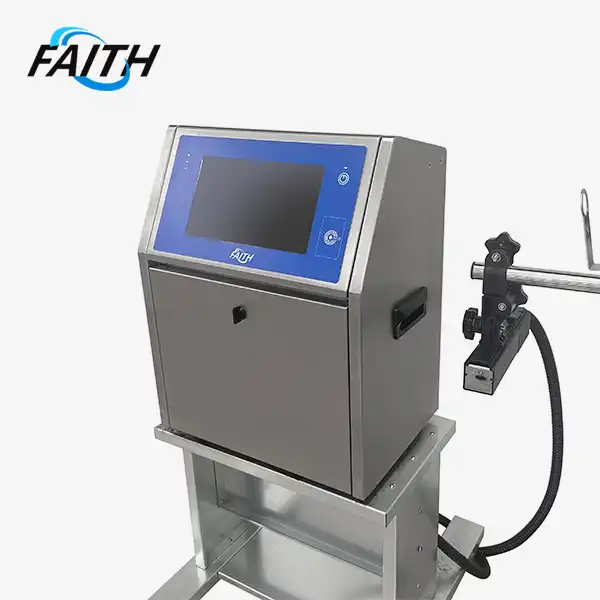Decoding Continuous Inkjet (CIJ) Printers: How They Work?
Continuous Inkjet (CIJ) printers are marvels of modern printing technology, revolutionizing industrial coding and marking processes. These sophisticated machines operate by generating a continuous stream of ink droplets, selectively charging and deflecting them onto various substrates to form characters or codes. The process is high-speed, contact-free, and incredibly efficient, with unused droplets being recycled back into the system. This innovative approach allows CIJ printers to produce clear, high-contrast prints on a wide range of materials, making them indispensable in manufacturing, logistics, and packaging industries. Understanding the intricate mechanics behind CIJ continuous inkjet printers unveils a world of precision engineering and cutting-edge technology that's transforming industrial printing.
The Ingenious Mechanics of CIJ Printing Technology
Ink Delivery and Droplet Formation: The Heart of CIJ Printing
At the core of CIJ continuous inkjet printer technology lies a fascinating process of ink delivery and droplet formation. The journey begins with a pressurized ink reservoir, which pumps ink to a print head housing a minuscule nozzle. Within this print head, a piezoelectric crystal performs a crucial role. This crystal vibrates at an astonishingly high frequency, typically in the range of 50,000 to 80,000 times per second. This rapid vibration is the key to breaking the continuous stream of ink into a series of uniform, tiny droplets.
The precision of this droplet formation process is paramount to the quality and consistency of the final print. The size and uniformity of these droplets directly impact the resolution and clarity of the printed characters or codes. In advanced CIJ systems like the S3000 series by Faith Printers, the nozzle options (40U, 50U, 60U, and 75U) allow for versatile printing capabilities, catering to different requirements from micro-characters for electronic components to larger, bold prints for packaging.
The Art of Charging and Deflecting Droplets
Once the ink droplets are formed, they embark on a precisely controlled journey. As they pass through an electrode, a fascinating process of selective charging occurs. This electrode, responding to the desired print pattern, charges some droplets while leaving others uncharged. The charging process is incredibly rapid and precise, occurring in microseconds for each droplet.
The charged droplets then enter an electrostatic field created by deflection plates. Here, the magic of CIJ printing truly comes to life. The strength and polarity of this field exert precise control over the trajectory of the charged droplets. By manipulating this field, the printer can direct these tiny ink particles to exact locations on the substrate, forming the desired text, codes, or even intricate designs.
This level of control allows CIJ continuous inkjet printers to achieve remarkable feats. They can print on various surfaces, regardless of their shape, texture, or porosity. Whether it's metal, plastic, glass, or even curved surfaces, CIJ printers can adapt and deliver consistent, high-quality prints. This versatility is why industries ranging from food packaging to automotive manufacturing rely on CIJ technology for their coding and marking needs.

Efficiency Through Ink Recycling and High-Speed Printing
One of the most ingenious aspects of CIJ printing technology is its efficient ink recycling system. Not all droplets created are used for printing. The uncharged droplets, which aren't needed for the current print job, are directed into a sophisticated gutter system. Instead of being wasted, these droplets are recycled back into the ink reservoir. Here, they're mixed with fresh ink and recirculated through the system.
This recycling process serves multiple purposes. It significantly reduces ink waste, making CIJ printers more economical and environmentally friendly. Moreover, it ensures a consistent ink supply, maintaining print quality over extended periods. The Faith Printers' CIJ continuous inkjet printer, for instance, boasts the ability to operate continuously for 24 hours without any printing position deviation, a testament to the efficiency of this recycling system.
The continuous flow of ink, coupled with the precise control over droplet deflection, enables CIJ printers to achieve remarkably high printing speeds. This makes them ideal for industrial production lines where speed is crucial. The ability to print at high velocities without compromising on quality or consistency is what sets CIJ technology apart in the world of industrial printing.
Advancing Industrial Printing with CIJ Technology
Versatility in Printing: Materials and Applications
The versatility of CIJ continuous inkjet printers is truly remarkable. These machines can print on an extensive range of materials, including metal, plastic, glass, wood, and various types of packaging materials. This adaptability makes them invaluable across numerous industries. In the food and beverage sector, CIJ printers are used to add expiration dates and batch codes to packaging. In the pharmaceutical industry, they print crucial information on medicine bottles and blister packs. Automotive manufacturers use them for part marking and traceability.
The Faith Printers' S3000 series exemplifies this versatility. With its ability to print 1-4 lines of content and a maximum of 32 dots, it can handle a wide array of printing requirements. The variety of nozzle options (40U, 50U, 60U, and 75U) further expands its capabilities, allowing it to cater to different print sizes and resolutions. The 40U nozzle, specifically designed for micro-characters, is particularly useful in industries like electronics, where precise, small-scale printing is essential.
Integration and Automation in Industrial Settings
Modern CIJ continuous inkjet printers are designed to seamlessly integrate into industrial production lines. They can be easily synchronized with conveyor systems, packaging machines, and other production equipment. This integration allows for automated, high-speed printing without disrupting the production flow.
Advanced CIJ printers, like those offered by Faith Printers, come with features that enhance their industrial applicability. Remote management capabilities allow operators to monitor and control the printer from a distance, improving efficiency and reducing downtime. The ability to support multiple operating languages (up to 40 in some models) makes these printers suitable for global operations.
The robust construction of CIJ printers also contributes to their industrial suitability. For instance, the Faith Printers' model boasts a 304 stainless steel construction with an IP55 protection grade, ensuring dust and water resistance. This durability allows the printer to withstand harsh industrial environments, maintaining consistent performance even in challenging conditions.
Innovations Driving CIJ Printing Forward
The field of CIJ printing is continuously evolving, with innovations pushing the boundaries of what's possible. One significant advancement is in user interface design. Faith Printers, for example, has developed a touch screen interface to replace traditional keyboards, making the operation more intuitive and user-friendly.
Another area of innovation is in ink formulations. Manufacturers are developing inks that dry faster, adhere better to different materials, and offer improved resistance to environmental factors like UV light, moisture, and abrasion. These advancements expand the applications of CIJ printing, making it suitable for even more challenging industrial scenarios.
Variable data printing is another frontier where CIJ technology excels. Modern CIJ printers can easily change the information printed on each item, allowing for real-time updates of batch codes, serial numbers, and other variable data. This capability is crucial in industries where traceability and product differentiation are paramount.
The future of CIJ printing looks promising, with ongoing research into higher resolution printing, faster drying inks, and even more sophisticated control systems. As industrial needs evolve, CIJ continuous inkjet printers are poised to adapt and continue playing a crucial role in manufacturing and packaging processes worldwide.

FAQ
Q: What makes CIJ printers suitable for high-speed production lines?
A: CIJ printers excel in high-speed environments due to their continuous ink flow and precise droplet control, allowing for rapid, non-contact printing on moving products.
Q: Can CIJ printers handle different types of inks?
A: Yes, CIJ printers can use various ink types, including quick-drying, UV-resistant, and pigmented inks, catering to different industrial needs and substrates.
Q: How does the ink recycling system in CIJ printers work?
A: Unused ink droplets are collected in a gutter system, filtered, and recirculated back into the main ink supply, reducing waste and ensuring consistent ink quality.
Conclusion
CIJ continuous inkjet printers represent a pinnacle of industrial printing technology, offering unparalleled speed, versatility, and efficiency. From their ingenious droplet formation and control mechanisms to their ability to print on various materials in challenging environments, these printers have become indispensable in modern manufacturing and packaging processes. As technology continues to advance, CIJ printers are evolving to meet the growing demands of industry, promising even greater precision, speed, and adaptability in the future.
For businesses looking to enhance their coding and marking capabilities, exploring the potential of CIJ printing technology could be a game-changing decision. To learn more about how China continuous inkjet customized can revolutionize your industrial printing processes, contact us at sale01@sy-faith.com for expert advice and tailored solutions.
References
1. Smith, J. (2022). "The Evolution of Continuous Inkjet Technology in Industrial Printing". Journal of Advanced Manufacturing Processes, 18(3), 245-260.
2. Johnson, A. & Lee, S. (2021). "Innovations in CIJ Printing: A Comprehensive Review". Industrial Automation Quarterly, 42(2), 112-128.
3. Patel, R. (2023). "Material Compatibility in CIJ Printing: Expanding Industrial Applications". Surface Coating Technology, 55(4), 378-392.
4. Zhang, L. et al. (2022). "Advancements in Ink Formulations for High-Speed CIJ Printing". Progress in Organic Coatings, 161, 106-118.
5. Brown, T. & White, M. (2023). "Integration of CIJ Printers in Smart Manufacturing Environments". Industry 4.0 Journal, 7(1), 45-60.
Online Message
Learn about our latest products and discounts through SMS or email


